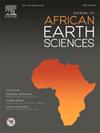Modeling overthrust structures for hydrocarbon exploration by 3D magnetotellurics
IF 2.2
4区 地球科学
Q2 GEOSCIENCES, MULTIDISCIPLINARY
引用次数: 0
Abstract
The seismic reflection method is widely used in hydrocarbon exploration due to its ability to provide detailed imaging of sedimentary layers. However, in overthrust terrains where high velocity rocks (e.g., volcanic cover) overlie low velocity sediments, seismic methods often struggle to distinguish hydrocarbon-bearing zones from other sedimentary layers. These challenges arise due to seismic velocity reduction at the base of volcanic layers and the dispersive nature of volcanic rocks. In such complex geological settings, magnetotellurics (MT) offers an alternative approach, as it can penetrate deeper and resolve subsurface resistivity contrasts more effectively. This study evaluates three-dimensional (3D) MT for hydrocarbon exploration in overthrust settings with high resistivity cover layers. Synthetic models incorporating overthrust structures were developed, and their MT responses were analyzed through 3D inversion. The results demonstrate that 3D MT inversions adequately recover hydrocarbon-bearing structures but may underestimate their resistivity due to the influence of overlying layers. Constrained inversions, incorporating additional constraints such as basement resistivity values, improve overall model resolution, yet do not significantly enhance hydrocarbon trap definition. These findings suggest that incorporating additional constraints can enhance subsurface imaging. Ultimately, this study suggests that 3D MT should be more widely utilized in contractional tectonic settings, particularly in fold-and-thrust belts, to enhance hydrocarbon exploration strategies. While MT alone provides valuable imaging capabilities, its integration with other geophysical methods could further improves inversion accuracy and hydrocarbon detection in complex geological environments.
逆冲构造的三维大地电磁建模与油气勘探
地震反射法由于能够提供沉积层的详细成像,在油气勘探中得到了广泛的应用。然而,在高速岩石(如火山覆盖层)覆盖低速沉积物的逆冲构造中,地震方法往往难以将含油气带与其他沉积层区分开来。这些挑战是由于火山底部的地震速度降低和火山岩的分散性造成的。在这种复杂的地质环境中,大地电磁(MT)提供了一种替代方法,因为它可以穿透更深,更有效地解决地下电阻率对比。本研究评价了逆冲构造中高电阻率覆盖层油气勘探的三维MT方法。建立了包含逆冲构造的综合模型,并通过三维反演分析了其大地电磁学响应。结果表明,三维MT反演可以充分恢复含油气构造,但由于上覆层的影响,可能会低估其电阻率。约束反演纳入了基底电阻率值等附加约束条件,提高了整体模型分辨率,但并未显著提高油气圈闭的定义。这些发现表明,加入额外的约束条件可以增强地下成像。最后,本研究建议在收缩构造环境下,特别是在褶皱和冲断带,三维大地电磁法应得到更广泛的应用,以提高油气勘探策略。虽然MT单独提供了宝贵的成像能力,但它与其他地球物理方法的结合可以进一步提高反演精度和复杂地质环境下的油气探测。
本文章由计算机程序翻译,如有差异,请以英文原文为准。
求助全文
约1分钟内获得全文
求助全文
来源期刊

Journal of African Earth Sciences
地学-地球科学综合
CiteScore
4.70
自引率
4.30%
发文量
240
审稿时长
12 months
期刊介绍:
The Journal of African Earth Sciences sees itself as the prime geological journal for all aspects of the Earth Sciences about the African plate. Papers dealing with peripheral areas are welcome if they demonstrate a tight link with Africa.
The Journal publishes high quality, peer-reviewed scientific papers. It is devoted primarily to research papers but short communications relating to new developments of broad interest, reviews and book reviews will also be considered. Papers must have international appeal and should present work of more regional than local significance and dealing with well identified and justified scientific questions. Specialised technical papers, analytical or exploration reports must be avoided. Papers on applied geology should preferably be linked to such core disciplines and must be addressed to a more general geoscientific audience.
 求助内容:
求助内容: 应助结果提醒方式:
应助结果提醒方式:


